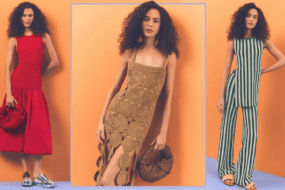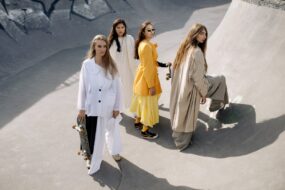
Fashion is far more than a means of covering the body; it is a profound form of expression, identity, and communication. Across centuries, clothing has not only reflected individual style but also signaled broader social, political, and cultural meanings. In the context of contemporary fashion, culture plays a significant role in shaping trends, from global streetwear movements to high-fashion runways. This essay explores how various aspects of culture—such as ethnicity, music, art, technology, social media, and globalization—continue to mold the fashion industry in the 21st century.
The Concept of Culture in Fashion
Culture encompasses the beliefs, customs, arts, and collective identity of a particular group or society. When translated into fashion, culture becomes a vehicle through which people communicate their heritage, values, and societal positions. Fashion is often influenced by cultural events, traditions, and societal changes, serving as a mirror to what is happening in the world. This interplay between culture and clothing creates a dynamic and evolving fashion landscape that is constantly being redefined.
Traditional Cultural Influences in Contemporary Design
Designers frequently look to traditional garments and cultural practices as sources of inspiration. Whether it is Japanese kimonos, Indian saris, or African Ankara prints, cultural dress continues to be reimagined in modern collections.
For example, designers like Dries Van Noten, Rei Kawakubo (Comme des Garçons), and Stella Jean have all paid homage to various cultural aesthetics in their work. While Van Noten often incorporates Eastern textile techniques, Stella Jean is known for combining European tailoring with bold Haitian and African prints. These cultural references offer depth and meaning to collections while celebrating heritage and diversity.
However, this practice also raises important conversations around cultural appropriation versus appreciation. Cultural appropriation occurs when elements of a culture are borrowed in a disrespectful or exploitative manner—often by a dominant culture without permission or understanding. In contrast, cultural appreciation involves respectful collaboration and recognition. As global awareness grows, many designers and fashion houses are becoming more sensitive to these distinctions, often working directly with artisans from the cultures they reference.
The Rise of Streetwear and Youth Culture
No discussion of contemporary fashion would be complete without addressing the impact of streetwear—a movement born from urban youth culture in cities like New York, Los Angeles, and Tokyo. Originating from skateboarding, hip-hop, and graffiti scenes in the 1980s and 1990s, streetwear has grown into a global phenomenon.
Brands like Supreme, Off-White, and A Bathing Ape have become household names, with their designs heavily influenced by local culture, music, and political commentary. Streetwear reflects the voices of marginalized communities and serves as a rebellion against traditional fashion norms. The democratization of fashion through streetwear has allowed everyday consumers to shape and influence trends as much as luxury designers.
Moreover, streetwear exemplifies how cultural trends can be monetized and scaled globally. Collaborations between luxury brands and streetwear labels, such as Louis Vuitton x Supreme or Dior x Travis Scott, show the fashion world’s acknowledgment of youth culture as a driving force. These partnerships not only redefine fashion aesthetics but also break down traditional barriers between luxury and casual wear.
Music and Its Cultural Impact on Fashion
Music has always had a powerful connection to fashion, acting as both muse and amplifier. Different genres—whether it be hip-hop, punk, rock, or K-pop—come with distinct fashion identities that influence mainstream trends.
In the hip-hop world, artists like Kanye West, Pharrell Williams, and Rihanna have transitioned into fashion moguls, using their music platforms to launch brands and dictate style. Yeezy by Kanye West is a prime example of music culture influencing contemporary fashion through minimalist, utilitarian aesthetics.
On the other hand, K-pop has become a cultural and fashion export from South Korea, with groups like BTS and BLACKPINK setting global trends. Their eclectic, vibrant styles combine Korean traditional elements with avant-garde fashion, influencing millions of fans worldwide. These artists often partner with high-end labels like Chanel, Gucci, and Louis Vuitton, showing how music and fashion mutually reinforce each other.
Art and Cultural Storytelling in Fashion
Artistic movements have always shaped fashion trends. From the surrealism of Elsa Schiaparelli to the pop art prints of Versace, fashion often acts as a canvas for artistic expression. Today, this fusion is more apparent than ever.
Designers like Virgil Abloh integrated elements of architecture, sculpture, and contemporary art into his Off-White collections. Similarly, fashion houses such as Dior and Loewe regularly collaborate with artists and incorporate fine art references into their lines. These collaborations not only enrich design narratives but also create cultural commentary through visual storytelling.
Fashion exhibitions at museums, such as the Metropolitan Museum of Art’s Costume Institute, further bridge the gap between fashion and art, elevating fashion to a respected cultural form. The 2018 “Heavenly Bodies: Fashion and the Catholic Imagination” exhibition highlighted how religion and spirituality—powerful cultural forces—intersect with fashion design.
Technology and Digital Culture’s Role in Shaping Trends
As society becomes increasingly digital, culture has expanded to include online communities, gaming, and virtual reality. These new digital subcultures now heavily influence contemporary fashion.
Virtual fashion shows, digital avatars, and NFT-based clothing are revolutionizing how fashion is consumed and perceived. Brands like Balenciaga and Gucci have embraced the digital age with collections that can be worn in video games like Fortnite or platforms like Roblox. In doing so, they acknowledge that modern culture is no longer just physical—it’s immersive and interactive.
Moreover, digital fashion allows for unprecedented creativity, unbound by material limitations. Digital influencers like Lil Miquela—an AI-generated avatar—demonstrate how virtual culture can blur the lines between reality and fiction while still dictating real-world fashion trends.
Social Media, Influencers, and Cultural Movements
Social media platforms like Instagram, TikTok, and Pinterest have transformed the way fashion trends are created and disseminated. Unlike the traditional top-down approach, where fashion houses dictated trends, today’s culture allows anyone with a smartphone to become a trendsetter.
Cultural movements such as body positivity, gender fluidity, and sustainability have gained momentum through online platforms. These movements are redefining fashion ideals and promoting inclusive design. For instance, gender-neutral collections by brands like Telfar and Collina Strada challenge conventional norms and celebrate identity diversity.
TikTok, in particular, has accelerated micro-trends such as “cottagecore,” “dark academia,” and “clean girl aesthetic,” all of which stem from broader cultural moods or internet subcultures. These viral trends often reflect generational values and social commentary, such as a longing for simplicity, nostalgia, or rebellion.
The Influence of Globalization on Fashion Culture
Globalization has enabled unprecedented cultural exchange, bringing together diverse aesthetics and techniques from across the world. As a result, contemporary fashion is a melting pot of influences, often blending Eastern and Western styles.
Fast fashion retailers like Zara, H&M, and Uniqlo capitalize on this cultural fusion by quickly replicating runway trends that include multicultural elements. However, this speed and accessibility can dilute the original cultural significance, leading to homogenization or misrepresentation.
Conversely, globalization has also allowed indigenous and small-scale designers to reach global audiences. Fashion weeks in cities like Lagos, Mumbai, and Seoul showcase local talent and provide platforms for culturally-rich design to flourish. This decentralization of fashion power centers—from Paris, Milan, and New York to emerging markets—has enriched the global fashion narrative.
Fashion as a Cultural Response to Social and Political Issues
Fashion often reacts to the political and cultural climate of its time. Designers use their collections to comment on issues such as climate change, racial inequality, feminism, and LGBTQ+ rights.
For example, Maria Grazia Chiuri’s debut collection for Dior featured a shirt that read “We Should All Be Feminists,” referencing Chimamanda Ngozi Adichie’s influential TED talk. Similarly, Pyer Moss by Kerby Jean-Raymond infuses African-American history and activism into his runway presentations, turning fashion into a platform for social change.
These examples show how culture influences not only aesthetics but also the messaging behind clothing. Fashion becomes a form of protest, solidarity, or empowerment—a cultural response rather than just a commercial product.
Cultural Sustainability and Ethical Fashion
In the current era, sustainability is both a cultural and ecological necessity. The push for environmentally and ethically responsible fashion is deeply rooted in changing consumer values and cultural awareness about climate change, exploitation, and overconsumption.
Slow fashion, upcycling, and circular fashion models are gaining popularity as they align with a culture of mindfulness. Designers like Stella McCartney, Mara Hoffman, and Eileen Fisher lead the way by using eco-friendly materials and transparent supply chains.
Additionally, cultural traditions in textile craftsmanship—such as Indian handloom weaving, Peruvian alpaca production, or Indonesian batik—are being revived and incorporated into sustainable fashion initiatives. These practices not only support local economies but also preserve cultural heritage in an ethical framework.
Challenges and Responsibilities of Cultural Influence in Fashion
While culture inspires innovation, it also imposes responsibilities. Fashion brands must be aware of the cultural significance behind the elements they use. Misinterpretation or superficial borrowing can lead to backlash and accusations of insensitivity or exploitation.
Authentic representation and collaboration are crucial. The fashion industry must foster diversity not only in its designs but also in its workforce—from models and designers to executives and decision-makers. Inclusivity must be cultural, not just visual.
Consumers also play a role by educating themselves about the cultural roots of the trends they follow and supporting brands that respect cultural integrity.
Conclusion
The influence of culture on contemporary fashion trends is profound, multifaceted, and ever-evolving. From traditional garments reimagined on modern runways to viral internet aesthetics born from digital subcultures, culture continuously shapes what we wear and how we express ourselves through fashion. Whether through music, art, technology, or political commentary, fashion remains a reflection of the world around us.
As the industry moves forward, it must continue to engage with culture respectfully and thoughtfully. Only through cultural sensitivity, inclusivity, and authenticity can fashion remain a meaningful and transformative part of human expression. In essence, culture is not just an influence on fashion—it is its very foundation.






















